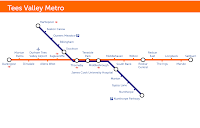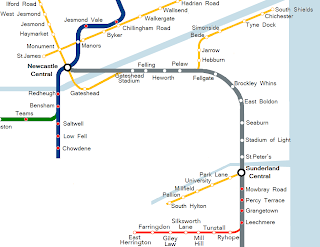
The last post about Washington discussed the Leamside route; a route which on the surface of things requires next to no work however it only bypasses Washington on its far eastern side and so would provide less than satisfactory service to the town. I believe that the main reason Washington doesn't currently have metro access is because Nexus will (can?) only follow this 'soft' route and see that it wouldn't give very effective service.
Ideally a Washington metro link needs to go right through the centre of the town. The Galleries area being a logical 'central point' for a Washington line. In an ideal world this would again of course involve lots of tunnels and slice right through the buildings. Of course though this is silly and is never going to happen.
There is though another option. The following is my proposed Washington route trying to strike a balance between good service and realism.
Since I'm tending towards the ideal here I will link this route to South Hylton in Sunderland (unlike with my last Washington post) to give Washington ( quick access to both of its neighboring cities; ideally what it needs.
So. Starting from South Hylton the track goes as follows:
Penshaw-Following a rebuilt Leamside line it makes sense to have a diversion to Penshaw rather than going straight over the Victoria Viaduct, it would be annoying for the Penshawers to have the track so near yet so far.
It is quite a diversion and so this station is entirely optional, Station Road would seem a smart place for the station though somewhere more north easterly would make the track less of a diversion and if the line isn't following Leamside directly could fit into more of a loop then a turn around.
Pattinson-Not far over the viaduct, just SW of the first ugly big white industrial estate building.
Teal Farm-Right at the edge of the estate, between it and Barmston (which this station could easily be named if not for the name being used elsewhere!) following the Leamside track.
Barmston-The track goes off the Leamside line at the top of the estate and follows the Sunderland Highway westwards with the station being towards the end of the estate.
By following the highway I mean just what I say.
Look at a typical large road- they have large green shoulders, often big enough that the motorway they are next to could double its size if further lanes were built on the green shoulders. This is more than enough room for a metro line to follow; right into the middle of town.
Washington Village-This station is perhaps a bit close to those on either side but it seems a logical place with a heavy residential area lying just to the south and Hertburn over the road.
The Galleries-As I've said a Galleries stop is really a requirement with a Washington metro. I would have the station more towards the Washington Highway end of the shopping centre so as to space the station a bit more from the Washington Village one.
Blackfell-This station would be on the opposite side of the A1231 than the others, having crossed a round about near The Galleries and it being just as easy to stay on the other side or cross. As with most of these motorway huggers having easy access from the others side of the road should be required though, which wouldn't be too hard.
This station again serves a large housing area and a industrial estate (Crowther), I would place it somewhat after the primary school.
Birtley-We've now left Washington and are heading towards Gateshead.
This station would be on the far north of the town, not in the best place really, but it is only here as we are passing Birtley anyway.
After Birtley there is a bit of a choice to make.
The by far easier way involves dashing for the east coast mainline and following that up to Newcastle central.
The harder route is to try and give Gateshead a more thorough metro service with lots of tunneling, two ways to do this could be:
1: Durham Road. Cut and Cover. The trouble here is it is a bit close to the railway anyway. Worth the effort? Nah.
2: Old Durham Road.
More central and there's also a lot of fields to skip into so its not all underground.
Construction though would still be very difficult and the reward nowhere near as great as in the main difficult area needing metro service- western Newcastle.
Overall the conservative route is by far the wiser. We will go to the railway line.
Allerdene- Not such a great place but its en-route to the railway line. Hook close to the town and there you go, just west of Durham Road.
Its not far north of the angel of the north (400 meters. Think a walk from haymarket station to monument station) which gives a bit of extra purpose to the station I suppose in tourism.
Chowdene-And we've joined the main railway line.
This station would be a rather important one in serving both the large residential area of Gateshead it is named for and Team Valley- Retail World being around 700 meters westwards and the rest of the huge industrial estate nearby.
Low Fell-Up near the Ravensworth Arms hotel seems a next wise stop.
Again this serves the Team Valley industrial estate (it is huge) as well as some housing.
After this we've immediately reached another choice as the track splits in two.
The first option is to take the more westerly route which we can follow to the previously mentioned Teams station then up to Bensham and beyond Newcastle.
The second option is to take the more easterly route which would take us straight to Bensham. Here there would be room for another station (which I would name Saltwell) which would give service to a large residential area.
I would tend towards option 2 here. The main deciding factor I would see being one of whether train scheduling would permit the metro to follow this route.
As mentioned in the Cramlington extension however extension of the track to add an extra lane or two at least in some places is always an option.













